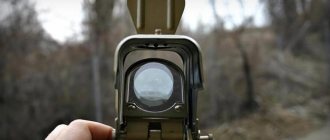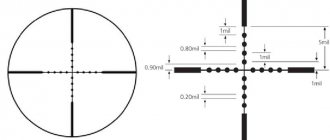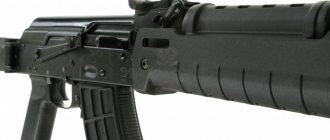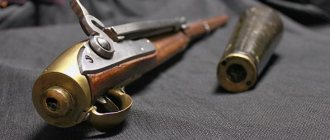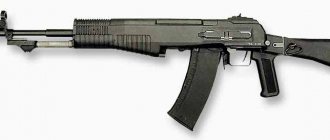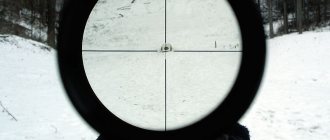In more modern systems, the aiming mark is provided by an LED mirror or lens optical system. In many shooting scopes, reddish reticle marks are formed that are clearly visible against almost any background, although, in general, the color and shape of the reticle may vary. Adjusting the brightness of the reticle allows you to adapt the sights to the lighting conditions and the shooter’s visual characteristics.
The essence of the operation of a collimator sight is that the optical system projects the image of the aiming mark towards the exit pupil of the sight, while the shooter sees the mark projected to infinity (an infinitely distant point), due to which the aiming line is formed.
In simple red dot sights, the aiming mark is applied as a dot on the front end of a glass prism or formed through frosted glass, which evenly scatters light and a narrow aperture.
In more modern systems, the aiming mark is provided by an LED mirror or lens optical system. In many shooting scopes, reddish reticle marks are formed that are clearly visible against almost any background, although, in general, the color and shape of the reticle may vary. Adjusting the brightness of the reticle allows you to adapt the sights to the lighting conditions and the shooter’s visual characteristics.
Anyone who has ever aimed at a target with a small weapon has learned from personal experience that aiming is not so easy, especially if you have not had much shooting practice. Collimator sights have a number of advantages that are significant for both beginners and experienced hunters. However, first, let's figure out what kind of device this is - a “collimator sight”, and then we’ll talk about its advantages and disadvantages.
Anyone who has ever aimed at a target with a small weapon has learned from personal experience that aiming is not so easy, especially if you have not had much shooting practice. Collimator sights have a number of advantages that are significant for both beginners and experienced hunters. However, first, let's figure out what kind of device this is - a “collimator sight”, and then we’ll talk about its advantages and disadvantages.
So, a collimator is a device that greatly facilitates the aiming process itself. Its peculiarity is that it has no focus and the distance at which it is located from the shooter’s eyes is, in principle, not decisive.
Collimators are divided into active and passive. The first ones are powered by batteries, and their aiming mark glows around the clock. Passive ones do not need external sources of energy, and this gives a certain advantage; The downside is that the reticle glows only during the day and at low twilight; it is low-contrast and dim.
There are also through and blind red dot sights. They differ in that, using through ones, you can aim with both one and two eyes, but using “blind” ones, or as they are also called stereoscopic, you need to aim with only two eyes.
Unlike a laser, the aiming mark of a collimator will not be detected by anyone, since it is, let’s say, virtual, only the shooter sees it. Therefore, such sights are effectively used not only in hunting, but also in military operations. It is important for snipers to remain undetected, therefore a laser sight can give them away, but a collimator cannot.
The disadvantage of collimator sights is that most of them are powered by batteries, which, in turn, do not tolerate low temperatures well. And if there is no power, then such a sight becomes a useless thing. Therefore, when buying a collimator, make sure that it is equipped with a quick-release bracket. If the scope fails, you can quickly remove it and continue hunting.
Avoid buying cheap collimators. We are not saying that high cost necessarily guarantees quality; simply, buying a sight that costs $15 is purchasing only a device that looks like a collimator, but otherwise has nothing in common with it.
When putting away the device, you need to use special packaging. They must be sealed, not allow moisture to pass through, and contact with aggressive media must be avoided. The temperature regime is recommended to be positive.
Features of operation
The essence of such a sight is that a luminous dot is projected on a small screen. This method has the following advantages:
- no need to focus your vision when aiming;
- Fire at targets is carried out at any angle of attack;
- you can conduct rapid, targeted shooting;
- in combat conditions allows you to better control the environment.
When operating the collimator, you must observe the same precautions as for any optical instrument. So the lenses are wiped exclusively with a special cloth that does not leave scratches. In the stowed position, special covers are used to protect the eyepiece; they are usually included in the kit. The covers protecting the adjusting devices and batteries must be screwed in all the way, but without applying force. For long-term storage, batteries/accumulators are removed.
When putting away the device, you need to use special packaging. They must be sealed, not allow moisture to pass through, and contact with aggressive media must be avoided. The temperature regime is recommended to be positive.
Collimators are divided into passive, which do not require a power source, and active, in which the aiming mark in the form of a bright dot is additionally illuminated and does not depend on the level of external illumination. To aim, it is enough to align it with the target, while the angle of view is completely unimportant, the main thing is not to lose sight of the target.
Brief overview of models
There are several well-known manufacturers producing collimators. Each brand has its own characteristics, advantages and disadvantages.
Cobra
A Russian manufacturer that specializes primarily in open-type models with the ability to adjust the brightness and type of marker. The differences between the models are mainly in the method of fastening.
- EKP-8-02 is fixed on the barrel using a side mounting system with movable levers located in hidden places to minimize the possibility of accidental pressing.
- EKP 8-18 has a different mounting method - a Picatinny rail.
- EKP-1S-03 is a device with a side sighting bar, the arrangement of the locking levers of which ensures maximum ease of installation and removal.
Eotech
American manufacturer with a good reputation. Devices of this brand are common among the military and tested in combat conditions. The high quality of these products corresponds to their high price. The manufacturer specializes in open sights of compact size and are mounted on a Picatinny rail as standard.
- Eotech 552.A65 is a standard model with good moisture protection and customization options.
- Eotech EOLAD-1V - has a laser designator built into the design, making it easier to fire from the hip.
- The Eotech XPS3 is a very compact model and is completely waterproof.
Aimpoint
Manufacturer from Sweden. The range of this brand includes many models for various purposes, both sights for military special forces and for hunters. Available with various mounting systems, allowing installation on almost any weapon. The quality and price are very high.
- The Aimpoint 9000L is an enclosed long sight for hunters. One of the most common models due to its versatility with multiple brightness levels, water resistance and resistance to mechanical damage.
- Aimpoint CompC3 is a closed model with a more compact size, more suitable for medium and close ranges.
- The Aimpoint Micro T-1 is a compact device used primarily on short-range shooting weapons.
Open sight
It is already hundreds of years old, but the combination of rear sight and front sight is not going to finally give up its position. In the simplest version, the rear sight is motionless, and the front sight cannot be adjusted. Basically, such devices have been preserved on smooth-bore weapons and are quite successfully used for short-range shooting. Frame sights, as a more advanced version, allow you to stepwise or smoothly adjust the aiming angle for long distances, which are divided into sectors of hundreds of meters.
1. Sight block. 2. Sector. 3. Sighting bar
For obvious reasons, sector sights have found their main application on rifled weapons, including military models.
The aiming technology itself is extremely simple and intuitive, but it implies strict requirements for the state of vision and, in general, for the “physics” of the hunter: it is one thing to keep the optical mark on the target, and quite another thing to keep the front sight located strictly in the center of the rear sight slot at the aiming point.
The figure shows a method of aiming “at the bull’s-eye” of a target; there is also a “bull’s-eye” option, but it is used mainly for pistols and its features are due to the purely military use of personal weapons.
The most simplified version of open devices is the sighting bar. It is most popular on shotguns intended primarily for shooting, when it is almost impossible to reliably align the front sight with the sight slot. In this case, the plane of the bar itself sets the aiming line and allows you to confidently work with the choice of lead.
Mostly there are monolithic and ventilated sighting strips. The latter are rather a tribute to fashion, as they provide the weapon with a more attractive appearance.
Rapid cooling is necessary when you have to fire many shots in a row, say, for clay pigeon shooting. In hunting practice, beautiful figured slots serve only as an additional dirt collector, of which there are already enough on weapons. The straps themselves are flat and grooved, narrow and wide (mainly on sporting shotguns).
In recent years, the classic front sight on open sights has often been replaced by fiber optic designs. Their light-gathering properties allow the shooter to concentrate as quickly as possible, in addition, they are high-contrast and provide additional advantages in low-light conditions.
The main disadvantage is low mechanical strength, and guns that were not originally intended for them also have incorrect self-installation in most cases. At the same time, due to the additional fasteners, the front sight goes up, and the gun begins to noticeably “lower.”
The good old open sight, being continuously modernized, has absolutely no intention of dying in the near future. Moreover, many mounts for optics on hunting and especially military weapons are designed in such a way that you can use the standard rear sight and front sight, for example, if the OP fails. There is another type of mechanical device - diopter (ring) sights.
They were not particularly widespread in hunting, being mainly limited to the military and sports spheres. In terms of aiming technique, when it is enough to align the front sight with the target without focusing on the rear sight, they resemble the heroes of the next review.
When using a weapon with a standard open sight, the shooter has to combine three objects on one axis at once: the front sight, the rear sight and the target. Only after this condition is met can a person be sure that the ballistic projectile will fly exactly to the target. This method significantly reduces the aiming speed and almost completely eliminates the possibility of firing while moving.
Types of collimators
Collimator sights are divided into closed and open. Initially, there was a serious difference between them:
With the development of technology, the need for closed sights gradually disappeared. Engineers realized how big the difference was between an open and a closed device and stopped producing the latter. Nowadays, most hunters use open collimator sights, in which the lens is mounted on a small frame that does not have a protective auxiliary structure around it.
But closed sights today are called a completely different device than a few years ago. A closed collimator is a sight whose lens is located inside a massive geometric structure. They also contain an additional focusing front lens. You can aim from such a unit with just one eye, so the understanding of the openness and closedness of collimators has changed significantly.
Such a device will increase the accuracy of fire by an order of magnitude, and therefore the tactical and technical characteristics of the weapon on which it will be used, military observer Viktor Baranets noted in a conversation with RT.
Historical technologies
The design and operating principle of a collimator sight allows the shooter to fire from an individual weapon with both eyes open, since it does not create a magnification effect, unlike optical sights. This allows you to quickly aim the weapon at the target at short and medium distances.
In fact, red dot sights replace traditional mechanical sighting devices: rear sights, stepped and frame sights and a front sight at the end of the barrel, which require closing one eye to use effectively.
Also, collimator sights allow you to more clearly identify a target in conditions of limited visibility, as well as “guide” moving objects.
The concept of reflex sights, which can quickly aim at a target without closing one eye, was developed at the beginning of the 20th century. The so-called Galilean sights were used during the First World War, but were not widely used.
Designers returned to this technology in the early 1970s, having at their disposal new polymer materials and technologies for projecting a red dot onto a non-optical sight. Then the American company Weaver presented its Qwik-Point collimator sight, which became the prototype of modern Red Dot sights.
Despite the fact that this sight significantly improved individual performance even among inexperienced shooters, it was not adopted by the US Army. However, there is evidence from military historians that Qwik-Point sights or similar devices were individually used by members of Green Beret detachments during sabotage operations at the very end of the Vietnam War.
Such sights became more widespread thanks to the Swedish company Aimpoint, which began producing them in 1975, significantly improving and simplifying the design. In 2000, the US Army officially adopted the Aimpoint CompM2 red dot sight under the M68 nomenclature.
In the USSR, collimator sights were traditionally used in aviation and were installed on mortars and anti-aircraft guns. However, they began to appear as sighting devices for individual small arms in Russia only in the late 1980s.
During the rearmament of the Russian army in the 2010s, more and more such devices began to appear in the troops. Thus, in 2015, the Valdai PK 120 sight was presented, which, based on the results of state tests, was recommended for adoption.
Recently, the Ministry of Defense announced the delivery of a large batch of collimator sights for Kalashnikov assault rifles to the mountain reconnaissance unit of the 49th Combined Arms Army, stationed in Karachay-Cherkessia.
“The sight is easy to use and has small dimensions, which allows reconnaissance officers to use it effectively during maneuverable combat. Aiming is performed using the reticle sighting mark, the image of which is located at the so-called visible infinity. The targeting reticle is illuminated at dusk by a radioluminescent source,” says the military department’s website.
In post-war red dot sights, it was mainly the lighting element that changed, and currently its role is played by the LED.
The figure shows a schematic diagram of a closed-type collimator sight.
Initially, collimator sights found application in aviation, and were installed both in fighter aircraft for firing from forward weapons, and on bomber turrets, for defensive machine guns and aircraft cannons.
The image of the aiming reticle was formed by a lamp located below the reflective glass (several glasses, a prism) and projected endlessly back, which allowed the pilot to aim with both eyes and at the same time clearly see both the target and the aiming mark on it.
At the end of the 40s, collimator sights migrated to firearms and hand-held weapons.
One of the first was the Nydar shotgun sight model 47. This sight appeared in the USA in the late 1940s. The Nidara sighting mark was designed for shot shooting, the central point at 50 yards covers approximately a 30 cm circle, the ring allows you to take a lead on a flying bird.
In post-war red dot sights, it was mainly the lighting element that changed, and currently its role is played by the LED.
Weapon red dot sights can be divided into two main subgroups: open type sights and closed type sights.
In open-type sights, the lens has a thin frame that practically does not obscure the aiming area. This is its main advantage. Such a sight is usually lighter, has its own mounting points, but is practically not protected from rain and snow, which makes it difficult to use in precipitation conditions. The most common open-type red dot sights at the moment include Docter, and variations on the theme of the Walther open sight.
In closed-type sights, the body is made in the form of a tube, inside of which optical parts and adjustment elements are located. Its advantages are the protection of all components, the ability to use in precipitation conditions (snow - rain), a clearer image of the aiming mark. Disadvantages: shadowing of the aiming area, greater weight compared to open-type sights. The most commonly found closed-type sights at the moment are represented by the Aimpoint M2 (M4), Aimpoint T1 line.
At the moment, the main disadvantage of collimator sights, from the point of view of military experts, is that the aiming mark is not visible in night vision devices; this drawback has been eliminated in holographic sights.
A holographic sight is an electro-optical device, on the glass of the exit window of which a holographic image of the aiming mark is recorded, which appears under the influence of laser radiation. The large and transparent reticle of such a sight is clearly visible in any lighting conditions and is located in the center of the sight, regardless of the viewing angle. The mark is visible only to the shooter and is absolutely invisible from the outside. The arrow is also visible in the NVG.
But at dusk there is nothing to do without backlighting. If you prefer power supply, then to avoid misunderstandings, carry a supply of batteries with you, or switch to lithium cells.
A collimator sight is the most affordable and simple type of optical device that helps the shooter quickly and accurately hit targets. There are many manufacturers and models of red dot sights. It is possible to install collimator sights on all types of small arms and pneumatic weapons.
They differ in both price and technical design. There are excellent collimators both in the lower price segment and expensive models that amaze with their technical novelty and perfection. We will look at how to choose a reflex sight in this article.
The principle of operation of a collimator sight.
The main difference between a collimator and other optics is the presence of glass on which or in which an aiming mark is projected using light. The light source can be either an artificial source in the form of an LED or laser, or natural light directed onto the glass using a light guide. Models, design, operating principles may change, but the two elements mentioned above will remain unchanged.
How are red dot sights classified?
Reticle projections along the trailer
.
Holographic sight.
(Some authors distinguish optics as a separate type)
By case type
By power supply for reticle illumination
Active (with power supplies)
Passive (naturally illuminated)
Compatibility with additional devices
(
night attachments
,
laser sights
,
“magnifers”
)
By fastening
Let's take a closer look at the classification.
Using the trailer, construct a projection of the aiming mark.
What is the difference between a collimator and a holographic sight?
In a collimator sight, the aiming mark is projected onto the glass surface due to the reflection of the light beam emanating from the light source. To prevent the light from the LED from being scattered onto the glass of the collimator, a coating is applied to block some of the light.
In a holographic (collimator) sight, the aiming mark is located inside the glass. Therefore, as a rule, holographic sights are devoid of sputtering.
Advantages and disadvantages of a collimator and a holographic sight.
A conventional collimator is cheaper, but has a larger parallax deviation. The holographic sight is more expensive, but it is almost not afraid of parallax. Also, a holographic sight is more demanding on power supply. Its batteries run out faster due to more powerful laser illumination.
By body type. Open and closed.
With open collimator sights
The glass on which the aiming mark is projected is installed without additional protection. As a rule, open sights are equipped with a single glass in a miniature housing. The advantage is the lightness of the sight, the absence of a narrowing of the field of view and more convenient aiming.
The downside will be greater susceptibility to contamination and mechanical damage due to impacts and other negative influences. Open sights are cheaper.
Closed collimators
protect the projection glass with an outer housing and two glasses located in the eyepiece part and at the lens site. Such sights are heavier, more expensive and their viewing angle is slightly smaller than open ones. But the survivability of such sights is much greater.
For resistance to shock loads.
According to the power sources for the illumination of the aiming mark.
In other words, with or without batteries. Without batteries, you are not afraid of long periods of operation and winter temperatures. These sights are simple, cheap and durable. A striking example is the VOMZ Pilad PFO 1x25 3MOA sight.
The sight is practically eternal.
But at dusk there is nothing to do without backlighting. If you prefer power supply, then to avoid misunderstandings, carry a supply of batteries with you, or switch to lithium cells.
Compatibility with additional devices
Additional equipment, or in common parlance “tuning,” significantly expands the scope of application of both the sight itself and the weapon system as a whole. If there is such compatibility, then we can add to the sight:
Laser pointer
(Laser) will make it easier to aim at the air and shoot at moving objects.
If desired, the target designator can be installed separately, but in some places it already comes as a built-in option
, such as on the Vortex RAZOR AMG UH-1 or Holosun INFINITI (HS401R5) sights.
"Magnifer"
- This is a magnifier that turns the collimator into an analogue of a daytime optical sight. Installed on the shooter's side. If necessary, it can be “thrown” to the side using a special fastener. When you need an increase again, with a slight movement of your hand you will return it back.
Night vision attachments
. If you need to shoot in the dark, make sure your scope has an NV mode. The backlight control should allow you to reduce the brightness to a minimum for comfortable work with the night light. Collimators are perfect for working in conjunction with night nozzles of generation 2+ and higher.
By fastening
And lastly, but not least. The mount is not as important a detail as the sight itself. If the sight cannot be securely mounted or even mounted on the weapon, then it’s a shame! Remember that not all scopes can be placed anywhere. Below the links you will see a list of sights for each type of mount.
Weaver or Picatinni
We will talk about the nuances associated with collimator sights in our future articles.
To understand the reasons for this difference in the areas of application of “optics” and “collimators”, as well as to evaluate the advantages of the latter, you should familiarize yourself with the most common sighting devices - open and optical sights.
Additional features
If you need a little more, there are options that cost extra money and can add a little functionality:
Magnifier
a magnifying lens that adds magnification to the lens and brings the target closer, but narrows the angle of view. All the advantages of collimators appear when shooting at a close, unexpectedly appearing or fast-moving target. No magnification is required, and for medium and long distances it is better to take optics - it will be more accurate and more convenient. The magnetizer is well suited for combined weapons with rifled and smooth barrels.
Night mode of the red dot sight
If you plan to hunt at night, you can mount a collimator and an inexpensive night vision monocular on one bar. The operation of devices in tandem is quite acceptable, the main thing is that there is enough space for installation. This is a practical and convenient solution, but you should take into account the brightness of the eyepiece of the NVD - you will need a sight with adjustable reticle brightness. In addition, you should take into account the resistance of NVGs to shock loads: not the best solution for 12-gauge and similar gauges.
Laser pointer
Military models are often equipped with target designators, like Arnold Schwarzenegger's in the movie "Terminator". They are intended for trained military personnel who have undergone special combat training and are suitable for self-defense. This is also available for many hunting models. The point of using a collimator sight with a laser designator is to expand the aiming range - from extremely short to long distances.
Simple and reliable
The optical sight does not have the described disadvantage. In addition to its well-known property of visually bringing the target closer, that is, increasing its apparent size, it has another extremely important advantage, which we will talk about a little later.
At first glance, the optical sight is simply beyond competition. And indeed it is! But only within strictly defined limits - when you need to make an ultra-precise shot at the maximum distance at a stationary or sedentary target, and there is more than enough time for aiming. In any other situations, the advantages of “optics” are more than balanced by its disadvantages.
One of the disadvantages is the need for precise positioning of the shooter's eye relative to the sight. Shifting the pupil in any direction from the sight axis by several millimeters immediately distorts the observed picture - the field of view loses the outline of a regular circle, and the position of the aiming reticle ceases to correspond to the point of impact. The permissible longitudinal displacement of the eye relative to the optical axis has a very limited range.
The main drawback, which is especially pronounced in “optics” with high magnification, remains an extremely limited field of view. The fact is that objects that do not fall into the viewing sector of the “optics” are located in focal planes much more distant than the aiming plane and are visible extremely blurred at the moment of aiming.
Therefore, when using “optics,” especially with high magnification, searching for even a stationary target through the eyepiece takes a lot of time. And when finding and holding an object in the field of view that is moving or appears for a short period of time, the effectiveness of “optics” is extremely low. For melee weapons, due to the “blind” zone, this type of sights is generally not applicable.
There are sights with a variable aiming point, which is determined by the size of the target and the distance.
Collimator sights
There are sights with a variable aiming point, which is determined by the size of the target and the distance.
In a collimator sight, an illuminated image of an aiming mark, usually a luminous dot, is created on the optical axis of the sight. Mark and target are equally sharp. The main difference between a collimator sight and an optical sight is the significantly larger diameter of the exit pupil (20-30 mm) and its unlimited offset, which makes it possible to not have to be particularly careful in placing the target - simply aligning the aiming mark with the target is enough.
Open and closed red dot sights
By their design, collimator sights are divided into closed and open. The collimator itself is used to form an image of the aiming mark and consists of an illuminator (point source of light), an aiming mark (diaphragm with a hole in the center) and a focusing lens.
A closed red dot sight is very similar in appearance to an optical sight, therefore it is well protected from external influences, usually has flywheels or buttons for adjusting the position of the aiming mark and is mounted on standard brackets for optics. Since in closed sights all elements of the collimation system are located along the optical aiming axis, partial shading of the field of view of the sight occurs, to which light loss in several lenses is added.
The magnitude of parallax for a collimator sight is determined in the same way as for an optical sight: the sight is fixed motionless and the shooter, moving his head left and right and up and down, observes through the sight whether the aiming mark moves relative to a stationary target located at the selected distance.
The aiming mark can be in the form of a dot, crosshairs, crosshairs with a break in the center, etc. A crosshair with a gap is the most practical, since the mark does not cover small or distant targets.
When choosing a collimator sight, you need to pay attention that the design elements or controls for the position of the aiming mark (handwheels or buttons) do not limit the field of view when aiming with both eyes open.
Some companies have begun to produce optical sights with variable magnification of 1-4x, which at a single magnification allow the optical sight to be used as a collimator - using all the advantages of the latter, and at high magnifications - as an optical one.
The holographic sight is compact and allows you to replace the plate with the reticle with another one, with a reticle image more suitable for the given shooting conditions, in a few seconds.
However, the widespread use of holographic sights is hampered by their significant price, relatively weak protection from external influences, and such a feature as the occurrence of color and geometric distortions of observed objects if bright light sources fall into the field of view of the sight.
Video
Watch our video on how to sight and adjust a red dot sight using the Aimpoint Micro T-1 model as an example.
Conventionally, hunting sights can be divided into two categories: purely mechanical devices and devices based on effects in optical glass - prisms and lenses. The first includes open and diopter sights, the second includes collimator and optical sights. The latter, due to the huge species diversity, deserve separate consideration; there are a good dozen main types of meshes alone.
